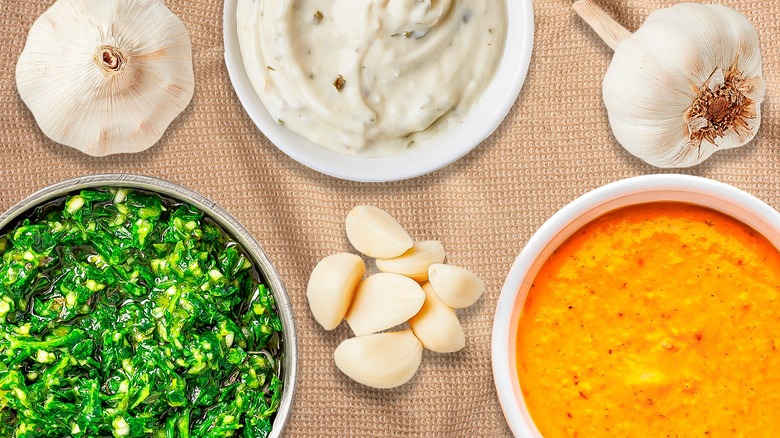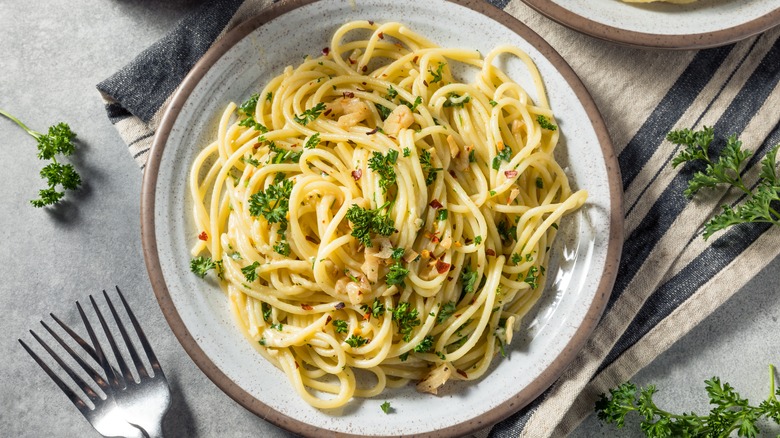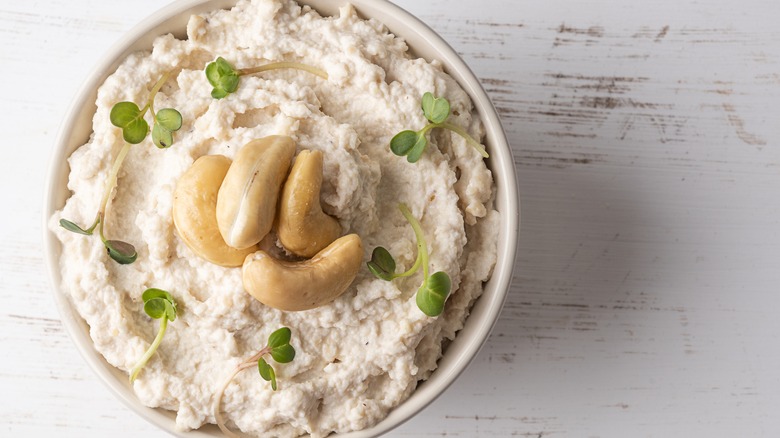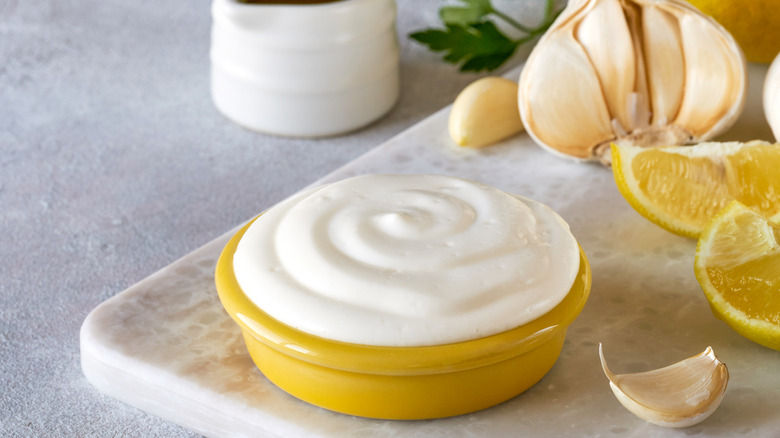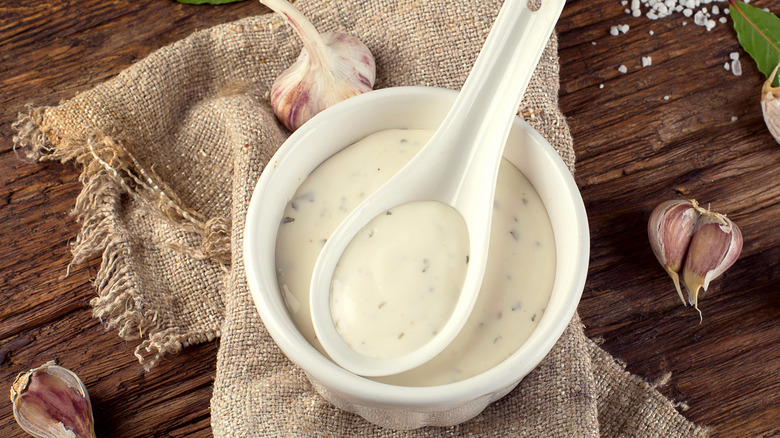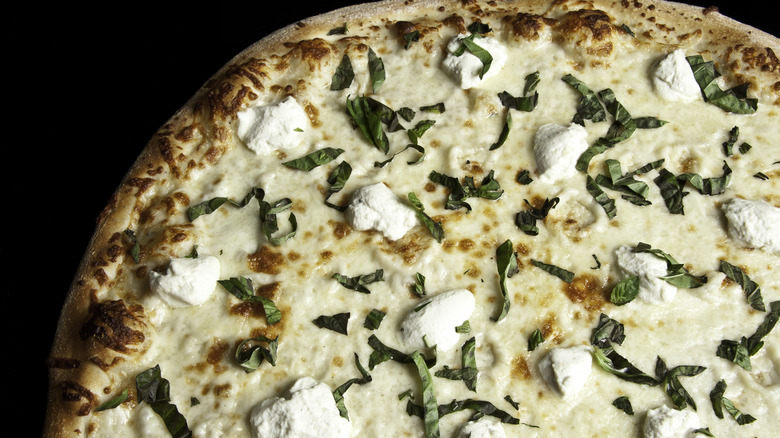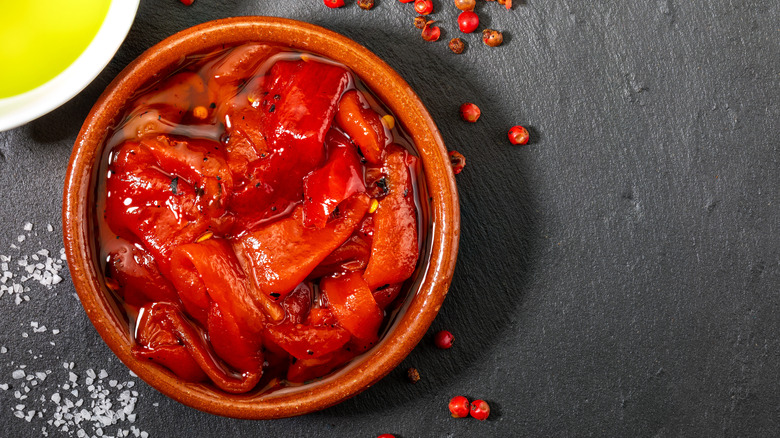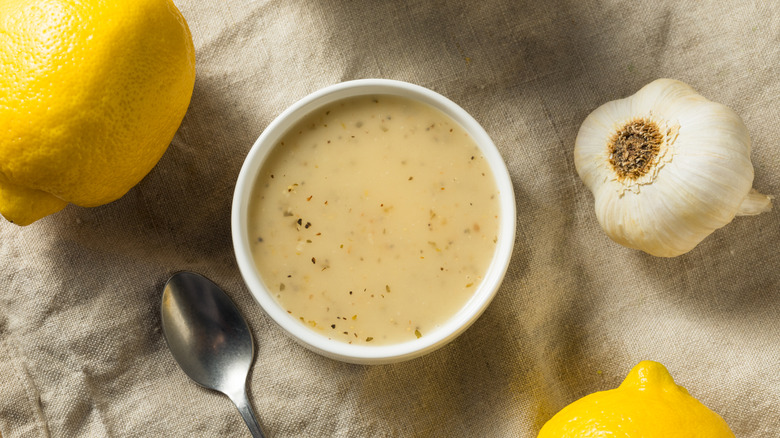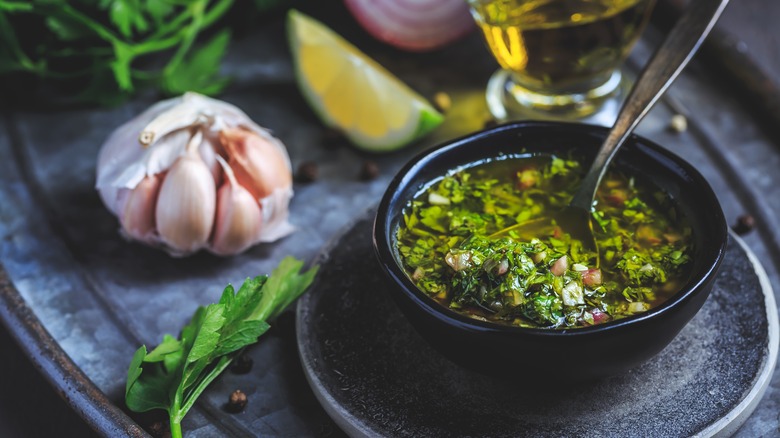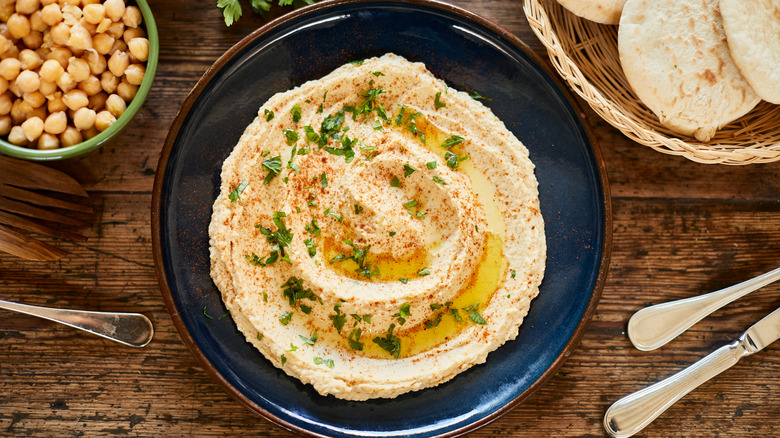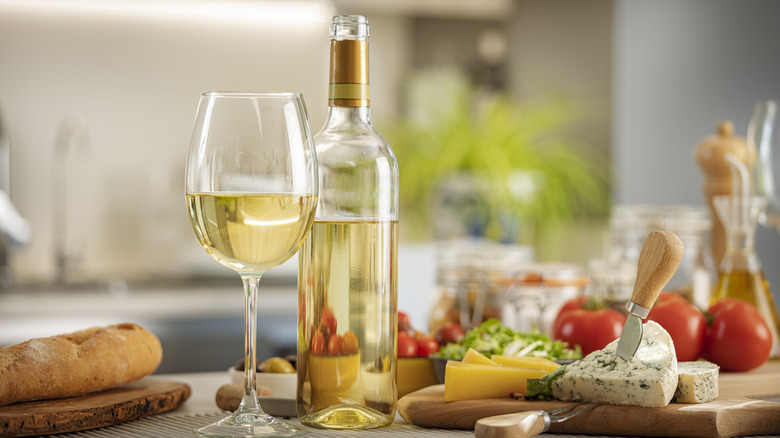11 Garlic-Based Sauces You Should Know
Garlic is a popular cooking ingredient for a reason. Just a little bit of this bulb vegetable goes a long way in adding much-needed flavor to pretty much any recipe. Its strength and unique flavor often mean it's featured as the main star of many dishes, whether it's being paired with other herbs and spices or replacing them entirely. From fresh cloves to easy-to-store garlic powder, there are plenty of different ways to incorporate it into your cooking. The easiest way to infuse your favorite dishes with garlic? With a garlic-based sauce, of course.
There are plenty of garlic sauce options out there, all with different flavors and uses. Looking to expand your culinary horizons and impress your dinner guests with your cooking prowess? We've got you covered. From the basics to the garlic sauces you've never even heard of, here are some garlic-based sauce recipes you should always have on hand.
Classic garlic butter sauce
If you're a fan of traditional, simple sauces, an easy garlic butter sauce should be your go-to. Perfect for pasta, meats, veggies, or homemade garlic bread, this sauce can have as few as just two ingredients; you guessed it, garlic and butter.
To vamp up the sauce, adding your favorite herbs will add a little extra flavor. Thyme and parsley are great for complementing garlic, while rosemary and oregano are also popular choices for a fragrant garlic herb sauce. For home cooks hoping to add more of a kick, cumin, paprika, and even chili flakes will create a spicy sauce base.
For meat, garlic butter provides a flavorful finish. Though it's not a good idea to cook steak with butter since it won't be hot enough to sear with, adding garlic butter sauce to the pan once your meat is almost done cooking will help to infuse the cut with flavor. Save a little extra sauce to drizzle over the top for the perfect finish. The sauce also creates a classic flavorful dip or drizzle for fish, lobster, and crab.
If you're looking to make a flavorful garlic pasta sauce, boil your noodles as usual and remove them just before they're done cooking. Then, add them to the pan with the garlic butter sauce. Don't rinse your noodles for this recipe; just allow the excess water to run off before mixing them into the sauce. This will help the sauce coat the noodles more evenly.
Garlic cashew sauce
Don't balk at the fact that this garlic sauce replaces dairy with cashews. The taste and texture mimic a light, cheesy sauce. This sauce takes almost no time to make and is a contender for one of the best garlic sauces out there, whether or not you follow a dairy-free diet. It even doubles as a dip or spread.
The key ingredient that gives this sauce its amazingly cheesy flavor is the nutritional yeast. As the name implies, the seasoning is made from deactivated yeast, and it's incredibly healthy. While nutritional yeast is often used as a topping, mixing it into this recipe will give your garlic sauce the perfect mix of natural cheesiness and garlicky flavor.
To make this sauce, you'll need to soak your cashews in water for at least two hours before using them. This softens them to a consistency that will make your sauce creamy instead of chunky when blended. Once they're ready, blend them with a clove of peeled garlic, salt, and some water. You can continue adding water after they've been pureed to change the thickness of your garlic sauce.
From dairy-free mac and cheese to creamy soups and pasta, garlic cashew sauce will quickly become your new staple sauce in the kitchen. It's so good you might feel tempted to just eat it with a spoon, but we'd probably recommend pairing it with veggies, chips, or crackers.
Lebanese garlic sauce
This fluffy garlic sauce, better known as toum, is a popular choice for garlic lovers. It's so thick it's practically a garlic spread, but the consistency literally makes it melt in your mouth as soon as you take a bite. The traditional ultra-garlicky toum recipe is even dairy-free.
Since it's commonly used as a paste or spread, this garlic sauce is extra heavy on the garlic. Most recipes will use a cup or more of peeled garlic cloves. The sauce also uses three cups of oil to blend with the garlic. If you're worried about the amount of oil, don't think too much of it — the strength of the sauce means it doesn't need to be used very heavily. A thin spread or small side of dip will give your dish plenty of flavor.
Slice your garlic, pop it in a blender or food processor with some salt, and blend it. Add the oil slowly, waiting for it to fully blend with the garlic before adding more. Continue this blending method until you've used up your oil. The traditional recipe also uses lemon juice, which can be slowly added to the mix alongside the oil. The great thing about this sauce is that it will stay fresh for multiple months, giving you plenty of time to use it.
Garlic aioli
To some, aioli is synonymous with flavored mayonnaise. But aioli's truest form isn't about adding ingredients to mayo. Classic aioli is made with just two ingredients: garlic and olive oil. Of course, seasonings are also a key part of any garlic aioli, whether you choose to keep things classic with a little salt and pepper or add an extra kick using chili flakes or paprika. If you're looking to achieve a better texture with your homemade garlic aioli, you can also add eggs to the mixture. Blend them with your garlic before adding the oil slowly. The end result should give you a slightly smoother aioli consistency.
Once emulsified with olive oil, garlic aioli is smooth, creamy, and super flavorful. The texture is often described as being similar to mayonnaise, which makes garlic aioli perfect for dips, sandwiches, and burgers. If you're a mayo-hater, don't run away from garlic aioli just yet — its flavor profile is very different from regular mayonnaise, and it's all thanks to the garlic. Plus, this garlic-based sauce makes it easy to add in endless flavor combinations, from pesto to truffle oil. Whether you sprinkle a few herbs on top or concoct an elaborate set of flavors for your aioli, this garlic-based sauce is delicious (even if you plan on sticking to the original recipe).
Garlic pizza sauce
If you're not familiar with white pizza — or "pizza bianca" — this fancy pie is made with no tomato sauce, giving it a pure white color. That doesn't mean that white pizza has no sauce at all, however — it's possible to make a flavorful pie even without a tomato base. After all, there's no better tomato sauce replacement than a bold white garlic pizza sauce — it might even mean you never go back to a basic red sauce pizza again.
White pizza sauce typically features cheese, oil or butter, milk, seasonings, and (of course) garlic. If you're intent on creating a white pizza sauce that will bake to perfection, fresh garlic is best, as it will provide the most flavor. However, this creamy white pizza sauce can also be made with garlic powder instead of fresh garlic cloves.
Even if you are busy peeling and crushing garlic, white pizza sauce is still super simple to make. You'll simply thicken melted butter (or oil) with flour over heat before adding in the milk. Once the sauce has become thick enough, you can add the rest of your ingredients and seasonings. It only takes a few minutes to create a unique, garlicky base for the perfect pizza.
Garlic romesco
This unique sauce's bright flavor and color come from roasted red peppers. But romesco's real secret is its smoky, layered taste — and this is where the sauce's garlic base comes in. To help bring out the flavor of the roasted peppers and create a layered flavor to the sauce, fresh garlic is key; without it, the red pepper flavor would be a little too overwhelming.
The art of creating a delicious smoky romesco sauce isn't too difficult, despite the sauce using several ingredients. You'll need peppers and tomatoes to start with — the fresher the better — along with balsamic, seasonings, oil, almonds, and garlic. Roast the vegetables together in a pan (you can pop the garlic in with them to speed things up a little). Make sure your almonds are dry before using them to get the perfect texture — if you want more nutty flavor, you can also add hazelnuts. Then you'll just need to blend your ingredients together once everything is done roasting.
Romesco is the ideal sauce for pastas and meats, and can also be used as a dip. It's a versatile sauce that is delicious served hot or cold, and it can keep for up to a week in the fridge. Just know that the longer you wait to use your romesco sauce, the stronger the garlic flavor will become — although that might actually be a good thing.
Garlic dressing
Garlic dressing is perfect for when you want to add extra flavor to salads, sandwiches, or even meat dishes. Although it's most commonly used as a salad dressing, it's extremely versatile due to its flavor and thickness. Garlic dressing is also a sauce that you can play around with a little bit; adding herbs is one of the easiest ways to achieve new flavors with garlic dressing. Though the dressing will have a slight tang to it, it's still got room to add spice using paprika or even a little bit of chili oil.
This creamy garlic dressing recipe calls for an entire bulb of garlic along with other key dressing ingredients like cream cheese and sour cream. Lemon juice and red wine vinegar are two extra ingredients that will help to offset the heaviness of the dressing and balance out the garlic with a little acidity. You can also change the consistency of your garlic dressing by adding milk.
Be careful when thinning down this garlic sauce, though — a little bit of milk will go a long way when changing the dressing's thickness. If you do accidentally thin it out too much, you can always add extra sour cream or cream cheese to bring back some of the thickness. Changing the consistency around too many times could take out some of the flavor, so add a small amount of milk or cream cheese at a time.
Garlic chimichurri
If you haven't yet heard of chimichurri, you've been missing out. It's a tangy, lightly spicy herb sauce that looks a lot like pesto at first glance —don't get the two confused, though, because chimichurri has a unique flavor profile that's all its own. Its oil base makes it perfect for pouring on salads, vegetables, and meats. This flavorful oil sauce is even known for being used to make deliciously flavorful scrambled eggs. Chimichurri's flavorful kick comes from one of its base ingredients — you guessed it, garlic. If you're a fan of herb sauces, this easy garlic sauce will soon become an essential staple in your recipe book.
Though some chimichurri recipes call for cilantro, those who have an aversion to the herb will be relieved to learn that you can replace it with parsley for the same result. Besides parsley and garlic, you'll need a lot of olive oil for the base of the sauce; the spice and tang of the sauce come from chiles and vinegar respectively. For an extra-hot flavor, fresh chiles are essential — if you're looking for a milder kick, chili flakes will do.
Fresh chimichurri sauce has plenty of different variations if you're looking to experiment. The few ingredients listed above are considered chimichurri staples, but you're free to add more herbs and spices from there. Once you've grabbed your ingredients of choice, all you have to do is thoroughly mince them and add the oil and seasonings. Simple.
Garlic hot sauce
Is your hot sauce not spicy enough for you? Are you looking to add more depth of flavor to your favorite hot sauce blend? Garlic is a hot sauce ingredient that can save even the blandest hot sauce from disaster. Hot sauces don't have to just be about creating spice; they should also have their own unique flavor profile that adds more to a just than just a feeling of spiciness.
Though most people will only consider the various kinds of peppers that go into making hot sauces, the other ingredients are just as important. Different kinds of peppers will create different levels of spiciness in the final recipe, but the other ingredients will add an actual flavor alongside the spice. Garlic is a key hot sauce ingredient that just doesn't get as much recognition as the others.
A good homemade hot sauce recipe will often use a large combination of many different ingredients to create flavors that shine through the spice. This also means that you'll be using a lot of garlic — fortunately, homemade hot sauce can last for a while in the fridge. Making hot sauce isn't always an easy pursuit, as it takes time to boil down the vegetables for maximum flavor. Even if you're scouring grocery store aisles for the perfect hot sauce mix to save time, you should keep an eye out for garlic in the ingredients list, along with plenty of peppers, vegetables, onions, and seasonings.
Garlic hummus or dip
Traditional hummus recipes use garlic to add flavor to the dip. Lemon, garbanzo beans, tahini, salt, and garlic are the five key ingredients to creating a delicious hummus (though the garlic base will also pair well with flavors like red pepper, herb, and smoky hummuses). To add even more powerful garlic flavor to your favorite hummus recipe, all you'll need to do is increase the amount of garlic you're adding to the mix.
Roasting two or more cloves of garlic per can of chickpeas in a hummus recipe will usually get you the garlicky result you're looking for. For the best and most evenly-roasted result, you should roast the entire bulb of garlic at once in an oven. To do this, you can just cut off the top part of the bulb — slightly exposing the cloves — before wrapping it in foil (leaving the top exposed so you can see the garlic cloves). Dowse the bulb in oil and leave it to roast until the cloves turn brown and smell fragrant.
If you're searching for a smoother, creamier dip that doesn't quite match hummus's consistency, you should know how to infuse garlic into a dipping sauce. To create a smooth garlic blend — such as in garlic mayo or garlic butter — you can substitute fresh garlic with garlic powder. This will create a perfectly smooth texture that can't quite be replicated with fresh garlic.
White wine garlic sauce
White wine sauce is a simple staple sauce that is perfect to have on hand for the times when you're just not sure what to make. There are many different variations on white wine sauces, with some using only white wine and broth and others using shallots, oil, or butter to mix with the wine. The best way to add delicate flavor to this sauce, however, is by using roasted garlic. This keeps the recipe simple, with just a few ingredients, but gives this straightforward sauce more depth. If you're debating what else to add, roasting the garlic in oil or butter first before adding seasoning and the white wine is an easy way to go. Broth, herbs, and even cream can change the flavor (and consistency) of the white wine sauce as well.
If you're looking to thicken your white wine garlic sauce, you can do so by adding a little bit of flour. This creates a heavier base for dishes that require a sauce that will cling to them more (such as creamy pastas). Whichever consistency you choose, this is by far one of the easiest recipes to make (and remember) if you're a fan of garlic.
